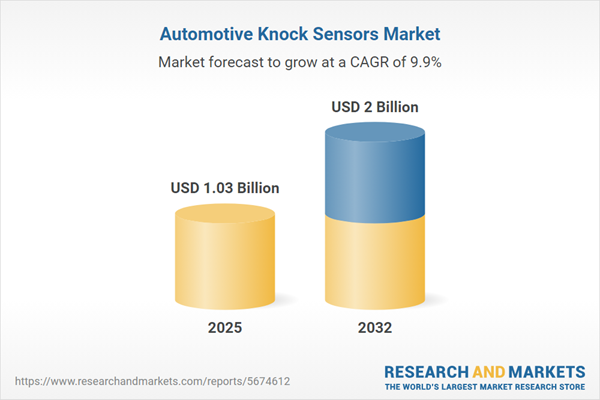Speak directly to the analyst to clarify any post sales queries you may have.
Senior leaders navigating the Automotive Knock Sensors Market face a fast-moving landscape shaped by regulatory change, emerging vehicle technologies, and complex supply networks. This market demands precise, informed decision-making for sustained competitiveness and compliance.
Market Snapshot: Automotive Knock Sensors Market
Global demand for automotive knock sensors is growing at a steady pace. In 2024, the market is valued at USD 942.34 million, with projections indicating an increase to USD 1.03 billion by 2025. This expansion is forecast to continue with a compound annual growth rate (CAGR) of 9.92% through 2032. Growth is driven by a combination of tightening vehicle emission standards, continuous advancements in powertrain engineering, and the integration of knock sensors in both hybrid and electric powertrains. The sector is characterized by rapid shifts in requirements, with expanded research and development improving engine monitoring and compliance. Collaboration between manufacturers and suppliers is increasingly important as demand for electric vehicles accelerates, directly impacting global supply chain configurations and procurement practices.
Scope & Segmentation
- Sensing Technology: The market relies primarily on MEMS and piezoelectric sensors, both recognized for their accuracy and swift response in capturing engine vibration and combustion anomalies, essential for optimizing both traditional and electrified drivetrains.
- Vehicle Category: Passenger cars, commercial vehicles, trucks, vans, and buses form the core segments, each demanding tailored safety, compliance, and integration standards. These requirements guide sensor deployment throughout consumer and commercial mobility sectors.
- Engine Fuel Type: Knock sensors are engineered for compatibility with gasoline, diesel, hybrid, and alternative fuel vehicles, supporting a broad range of emission standards and regional fuels policies, and ensuring adaptability as new powertrains emerge.
- End User: Both original equipment manufacturers (OEMs) and aftermarket suppliers utilize knock sensor solutions for integration in assembly lines as well as in updating older vehicle fleets, enabling scalable deployment and continuous operational support.
- Region: The Americas, Europe, Middle East & Africa, and Asia-Pacific each present distinct operational requirements, necessitating flexible logistics, region-specific supply strategies, and compliance with varied policy frameworks.
- Leading Companies: Key market leaders such as Robert Bosch GmbH, DENSO Corporation, and Continental AG influence benchmark standards in technology, supply reliability, and industry best practices, reinforcing their central role in reshaping procurement and supplier networks.
Key Takeaways for Senior Decision-Makers
- Comprehensive sensor offerings facilitate compliance with evolving automotive regulations and support multi-platform powertrains, making it possible for organizations to anticipate changes in emissions standards and adjust product lines accordingly.
- Advancements in sensor materials and manufacturing processes increase system durability and extend maintenance intervals, helping automotive fleets maximize uptime while reducing disruptions and associated costs.
- The integration of artificial intelligence within calibration tools and diagnostics allows for more accurate prediction of maintenance needs and earlier detection of engineering issues, leading to better fleet performance and operational efficiency.
- Broad adoption of digital asset management systems enhances real-time monitoring and streamlines lifecycle management for installed knock sensors, providing ongoing value for OEM and aftermarket stakeholders as vehicles age.
- Partnerships among automotive, semiconductor, and advanced materials sectors accelerate the pace of sensor innovation and speed up new product market entry, keeping organizations agile in rapidly changing technological environments.
- Targeted sourcing and procurement strategies attuned to shifting regional policies increase supply chain resilience, mitigating risk exposure for organizations as regulations and market conditions evolve in different regions.
Tariff Impact on Supply Chains and Manufacturing
Recent adjustments to US tariffs on imported sensor components have prompted manufacturers to revise production and sourcing operations. Companies now emphasize greater domestic assembly, maintain higher inventory buffers, and invest in automation. These practices stabilize operational costs, fortify supply chains, and help ensure consistent delivery of essential sensor parts, all central to meeting market demands and compliance obligations in a changing trade environment.
Methodology & Data Sources
This analysis draws on extensive interviews with engineering teams, industry executives, and sector experts, validated by regulatory and technical evaluation. Findings present a well-balanced and current perspective on knock sensor adoption, implementation strategies, and overall market competitiveness.
Why This Report Matters
- The report guides organizations through regulatory shifts, enabling effective benchmarking in technology adoption, supplier evaluation, and comprehensive supply chain compliance.
- In-depth analysis of emerging sensor technologies equips leadership with the foresight to optimize manufacturing and maintenance operations, ensuring business continuity.
- By highlighting strategic options in the face of regulatory and regional disruption, executive teams are better positioned for resilient and proactive decision-making.
Conclusion
Prioritizing technology integration and robust supply chain strategies enables organizations to navigate the evolving demands of the Automotive Knock Sensors Market with confidence. Continuous innovation and attentiveness to policy shifts will underpin sustained operational strength.
Additional Product Information:
- Purchase of this report includes 1 year online access with quarterly updates.
- This report can be updated on request. Please contact our Customer Experience team using the Ask a Question widget on our website.
Table of Contents
3. Executive Summary
4. Market Overview
7. Cumulative Impact of Artificial Intelligence 2025
Companies Mentioned
The companies profiled in this Automotive Knock Sensors market report include:- Robert Bosch GmbH
- DENSO Corporation
- Continental AG
- BorgWarner Inc.
- Hitachi Astemo, Ltd.
- NGK Spark Plug Co., Ltd.
- Infineon Technologies AG
- NXP Semiconductors N.V.
- STMicroelectronics N.V.
Table Information
| Report Attribute | Details |
|---|---|
| No. of Pages | 183 |
| Published | October 2025 |
| Forecast Period | 2025 - 2032 |
| Estimated Market Value ( USD | $ 1.03 Billion |
| Forecasted Market Value ( USD | $ 2 Billion |
| Compound Annual Growth Rate | 9.9% |
| Regions Covered | Global |
| No. of Companies Mentioned | 10 |









